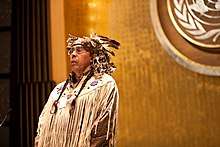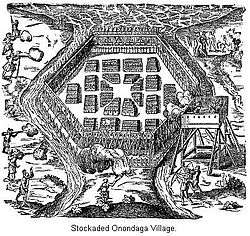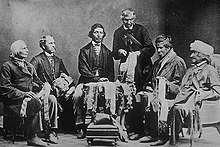Onondaga people
The Onondaga (Onöñda’gaga’ or "Hill Place") people are one of the original five constituent nations of the Iroquois (Haudenosaunee) Confederacy in northeast North America. Their traditional homeland is in and around present-day Onondaga County, New York, south of Lake Ontario. They are known as Gana’dagwëni:io’geh to the other Iroquois tribes. Being centrally located, they are considered the "Keepers of the Fire" (Kayečisnakwe’nì·yu’[1] in Tuscarora) in the figurative longhouse that shelters the Five Nations. The Cayuga and Seneca have territory to their west and the Oneida and Mohawk to their east. For this reason, the League of the Iroquois historically met at the Iroquois government's capital at Onondaga, as the traditional chiefs do today.
 Todadaho Sid Hill, Traditional Chief of the Onondaga Nation at the United Nations Permanent Forum on Indigenous Issues | |
| Regions with significant populations | |
|---|---|
| Languages | |
| English, Onondaga, Other Iroquoian languages. | |
| Religion | |
| Longhouse, Handsome Lake, Gai'hwi:io, Kanoh'hon'io, Kahni'kwi'io, Other Indigenous Religion | |
| Related ethnic groups | |
| Seneca Nation, Oneida Nation, Tuscarora Nation, Mohawk Nation, Cayuga Nation, other Iroquoian peoples |
History
According to oral tradition, The Great Peacemaker approached the Onondaga and other tribes to found the Haudenosaunee.[2] The tradition tells that at the time the Seneca nation debated joining the Haudenosaunee based on the Great Peacemaker's teachings, a solar eclipse took place. The most likely eclipse to be recounted was in 1142AD, which was visible to the people in the land of the Seneca.[3][4]
This oral tradition is supported by archeological studies. Carbon dating of particular sites of Onondaga habitation shows dates starting close to 1200AD ± 60 years with growth for hundreds of years.[5]

In the American Revolutionary War, the Onondaga were at first officially neutral, although individual Onondaga warriors were involved in at least one raid on American settlements. After Americans attacked on their main village on April 20, 1779, the Onondaga later sided with the majority of the League and fought against the American colonists in alliance with the British. After the United States was accorded independence, many Onondaga followed Joseph Brant to Upper Canada, where they were given land by the Crown at Six Nations.
On November 11, 1794, the Onondaga Nation, along with the other Haudenosaunee nations, signed the Treaty of Canandaigua with the United States, in which their right to their homeland was acknowledged by the United States in article II of the treaty.[6]
In 1816, 450 Onondaga were living in New York, 210 of whom lived on Buffalo Creek Reservation.[7]
Prestige Factors
The Onondaga Nation was crucial in forming the Iroquois League which led them to be very well revered by their peers. The "Tree of Peace" was planted on Onondaga Land.[8] Onondaga has been regarded as the capital of Iroquois land. The Onondaga were known as the Central Fire-Keepers of the Confederacy.[8] The Onondaga were known as the guardians or watch keepers of the league. They were keepers of the law in order to preserve traditions and institutions.[8] The culture hero Hyenwatha was an Onondaga Indian. He was essential in the early organization of the league.[8] The title of Thadodaho was always held by an Onondaga chief. He was to be the chief arbitrator of the Lords of the Confederacy.[8] The Onondaga maintained the largest number chieftainship titles as well as the largest number of clans among the Iroquois.[8] Handsome Lake, the Seneca prophet who was the author of the scripture thats about the new religion of the Iroquois died at Onondaga.[8]
Customs

The Onondaga practice the sprinkling of ashes when juggling the treatment of the sick.[9] They also do a public confession of sins upon a string of wampum.[9] The wampum is employed on all matters of public importance. Their funerals were known to be quiet and solemn with the females covering their faces.[9] There were also special events such as the Planting Feast which would happen in May or when the Onondaga believed the ground was ready. This was three days for penitential and religious services. One day for the children's dance, and one each for the Four Persons, the Holder for the Heavens, the Thunder, and for gambling.[9] The Strawberry Feast comes when the berries are ripe. This day there are dancing for the Thunder and a feast of strawberries.[9] The Green Bean Dance comes when the green beans are fit for use. This day there are dances for the Thunder and a mixture of war and feather dances.[9] The Green Corn dance always comes after the Green Bean dance. This day there are three days for religious services, one for the children, one for the Four Persons, one for the Holder of the heavens, and one for the Thunder with the feast.[9] The Onondaga's Thanksgiving feast in October closely resembled the Green Corn Dance.[9]
Culture
Some factors that defined Onondaga life were a continued placement of villages on defensive high points away from rivers and the presence of defensive earthen embankments.[10] A gradual evolution of pottery vessels and smoking pipe forms and decorations.[10] A gradual evolution of stone and bone tools and implements.[10] Continuity in subsitence systems.[10] Continuity of house forms and inferred communal living.[10] The continued use of human face motifs.[10] Evidence for bear ceremonialism and cannibalism.[10]
Government
The Onondaga in New York have a traditional form of government, with chiefs nominated by clan mothers, rather than elected.
On March 11, 2005, the Onondaga Nation in the town of Onondaga, New York, filed a land rights action in federal court, seeking acknowledgment of title to over 3,000 square miles (7,800 km2) of ancestral lands centering in Syracuse, New York. They hoped to obtain increased influence over environmental restoration efforts at Onondaga Lake and other EPA Superfund sites in the claimed area.[11] The Court of Appeals for the Second Circuit rejected the Onondagas' claim in 2012, and the Supreme Court in 2013 declined to hear an appeal.[12]
Sports
The Onondaga very much enjoyed sports and physical activity. Lacrosse and foot races were always known to be favorites of the Onondaga people.[13] They also adopted many games from European settlers such as mumble the peg, marbles, some games of ball, pull away, and fox and geese in the snow.[13] Hide and seek and blindman's bluff were played but no games with song.[13]
Notable people
- Leon Shenandoah (1915–1996), Tadodaho
- Oren Lyons [Lives at Onondaga and holds a Faithkeeper title, but is Seneca]
- Tom Longboat [Six Nations]
- Canassatego, Hiawatha, Tadadaho of the Iroquois Confederacy
- Tadodaho Sidney Hill
- Samuel George, ("Hononwirehdonh", or "Great Wolf"), (1795–1873; chief from 1850–1873)
- Lyle Thompson (professional lacrosse player), (1992-)
- Gail Tremblay (poet)
- Tonya Gonnella Frichner lawyer and activist (1947-2015)
- Eric Gansworth (poet, novelist and visual artist)
- Erik J. Sorensen (chemist)
Today
- Onondaga Nation south of Nedrow, New York outside Syracuse
- Onondaga of Ohswegen and Bearfoot Onondaga, both at Six Nations of the Grand River, Ontario, Canada
Other spellings encountered
- Onöñda'gega' Onondaga language
- Onontakeka Oneida language
- Onondagaono Seneca language
See also
- Hiawatha
- Onondaga language
- HMCS Onondaga (S73) Oberon Class submarine
- Sainte-Marie among the Hurons
- John Arthur Gibson
Notes
- Rudes, B. Tuscarora English Dictionary Toronto: University of Toronto Press, 1999
- Bruce E. Johansen (2006). The Native Peoples of North America: a History. Rutgers University Press. pp. 136–138. ISBN 978-0-8135-3899-0.
- Johansen, Bruce E. (Fall 1995). "Dating the Iroquois Confederacy". Akwesasne Notes New Series. 01 (3/04): 62–3. Retrieved 2020-02-09.
- Johansen, Bruce Elliott; Mann, Barbara Alice (2000). "Ganondagan". Encyclopedia of the Haudenosaunee (Iroquois Confederacy). Greenwood Publishing Group. p. 105. ISBN 978-0-313-30880-2. Retrieved 2010-05-23.
- Tuck, James A. (1990). Onondaga Iroquois Prehistory: A Study in Settlement Archaeology (reprint ed.). Syracuse University Press. p. 197. ISBN 978-0-8156-2511-7.
- "1794 Pickering Treaty With the Six Nations". 1794 Canandaigua Treaty Commemoration Committee, Inc. Archived from the original on 2006-04-26. Retrieved 6 September 2016.
- Hauptman, Laurence (2008). Seven Generations of Iroquois Leadership: The Six Nations Since 1800. Syracuse University Press. ISBN 978-0-8156-3165-1.
- Blau, Harold (1965). "Historical Factors in Onondaga Iroquois Cultural Stability". Ethnohistory. 12 (3): 250–258. doi:10.2307/480514. JSTOR 480514.
- Beauchamp, W. M. (1888). "Onondaga Customs". The Journal of American Folklore. 1 (3): 195–203. doi:10.2307/534235. JSTOR 534235.
- Hart, John P.; Engelbrecht, William E. (2016). "Revisiting Onondaga Iroquois Prehistory through Social Network Analysis". In Eric E. Jones; John L. Creese (eds.). Process and Meaning in Spatial Archaeology: Investigations into Pre-Columbian Iroquoian Space and Place. Boulder, CO: University Press of Colorado. pp. 189–214. doi:10.5876/9781607325109.c007. ISBN 9781607325109. JSTOR j.ctt1kc6hk0.15.
- Archived 2010-12-06 at the Wayback Machine, Syracuse Post Standard, n.d., accessed 11 Nov 2015
- "Supreme Court rejects Onondaga Indian Nation's land claim against New York". CNYCentral.com. 15 October 2013. Retrieved 29 June 2017.
- Beauchamp, W. M. (1895). "Onondaga Notes". The Journal of American Folklore. 8 (30): 209–216. doi:10.2307/534095. JSTOR 534095.
- "Current Clan Mothers." Haundenosaunee Confederacy. Retrieved 11 Sept 2012.
- Onondaga Reservation, New York United States Census Bureau